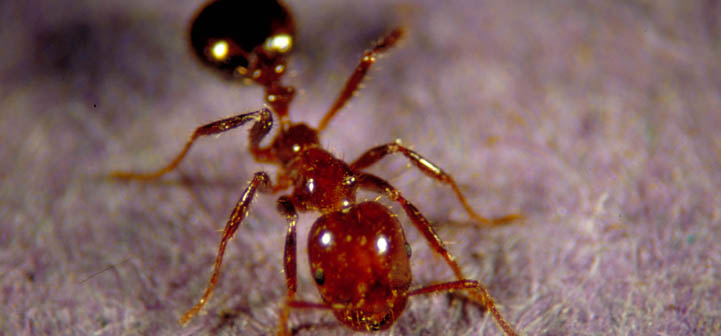What do fire ants look like? How can I tell them apart from other ants?
In the United States, imported fire ants currently inhabit all or parts of Alabama, Arkansas, California, Florida, Georgia, Louisiana, Missouri, Mississippi, New Mexico, North Carolina, Oklahoma, Puerto Rico, South Carolina, Tennessee, Texas, and Virginia. They are discovered sporadically in Maryland. The red imported fire ant has also been accidentally introduced to other countries. Imported fire ants will likely continue to spread throughout much of the southern portion of the U.S, and other parts of the world where climate conditions are suitable.
Accurate identification of fire ants can be especially important in the southwestern states, where native fire ant species are common and imported fire ants are rare. Although native fire ants are common urban pests, if they are controlled unnecessarily, especially in very dry climates, imported fire ants are more likely to invade new areas. For information about suspected fire ant invasions in West Texas and beyond, see the publication Living on the Edge: Management Considerations for Imported Fire Ants in Western Texas, Near or in Recently Infested Areas.
If you are unsure of the ant species you have, contact your county Extension office for identification help. Properly identifying ant species is the first step in determining the need and approach for control.
Here are some identification characteristics of imported fire ants:
 |
Red imported fire ant. Photo credit: Russ Ottens, University of Georgia, bugwood.org |
 Imported fire ants in comparison to other ants (photo by S. B. Vinson) Imported fire ants in comparison to other ants (photo by S. B. Vinson) |
 |
Side view of a fire ant. Nodes and stinger are visible. | |
 |
Dorsal view of fire ant showing two petiole nodes between the thorax and gaster (abdomen). These petioles are a fire ant characteristic. Photo credit: Josh Basham |
|
 |
Fire ants have elbowed antennae with 10 segments on each antennae. Photo credit: Josh Basham |
|
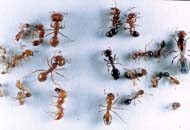 |
Fire ant specimens showing size and color variation. Photo credit: Bart Drees |
see also Common Ant Species found at Food Lure Baits |
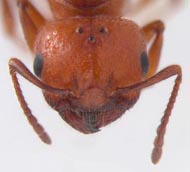 |
Fire ant head showing reddish brown coloration and elbowed antennae. Red imported fire ants have a reddish colored head and thorax. There may be gradations in color. Photo credit: Matt Yoder |
|
 |
Black imported fire ants are darker. Photo credit: Josh Basham |
Fire Ant Characteristics and Aggressive Nature
 |
 |
Fire ants are small, only about 1/8 to 1/4-inch long. Variation in size is a distinguishing feature. Many other ant species are uniform in size. |
Where imported fire ants are common, most homeowners recognize them by the mounds they build or the stings they inflict. Their aggressive nature compared to other ant species is one such trait. If a mound is disturbed, usually hundreds of fire ant workers will swarm out and run up vertical surfaces to sting.
 |
 |
 |
| Fire ant stings. | ||
 |
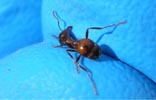 |
 |
 |
Worker ants bite with chewing mouthparts and inject venom with their stingers aggressively and repeatedly. If you get stung, you may feel burning or tingling at the site. A day or so later, the imported fire ant’s unique venom forms a characteristic white fluid-filled pustule or blister at the sting site. For more information, see Fire Ant Stings.
Watch what happens when a fire ant nest is disturbed: Disturbing a Fire Ant Mound.
How Can I Tell If I Have Fire Ants?
You May Have Fire Ants If…
- You see a mound of fluffy, worked soil, particularly a few days after a heavy rain.
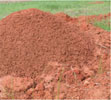 |
 |
 |
 |
- The mound has no opening in the center like most ant mounds. Imported fire ants leave and enter the mound through underground tunnels, radiating from the mound. In hard compact soils, these tunnels become visible on the surface. They also have tunnels extending down to the water table when no surface water is available.
 |
 |
 |
| Fire ant foraging trails. | ||
- Most mounds in turfgrass are just a few inches tall, but undisturbed mounds can reach 18 inches in height.
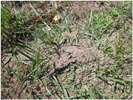 |
 |
 |
 |
 |
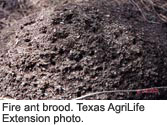 |
| Fire ant mound sites | Fire ant brood | ||||
- Soil type can also affect mound size. Mounds in clay soil are often larger than sandy soils.
- Mounds are often built up against structures or may be located at sites with less disturbance (e.g., fence rows).
- The white objects seen in the mound are the brood—the eggs, larvae and pupae of developing ants.
How do I collect fire ants to send in for identification?
Imported fire ants (Hymenoptera) can be collected at almost anytime of the year on warm days from their mounds.
Be aware of where you are standing and move away from mounds if ants crawl on your shoes. This must be done carefully so you do not get stung.
- Dust baby powder on dishwashing gloves and wear them because the ants cannot crawl up dusted surfaces (hold hands upright) and have adult supervision.
- Place rubbing alcohol in a vial and stick it into the top of an undisturbed mound. Worker ants will climb up and drop into the vial and drown.
- Quickly remove the vial and cap it with gloved hands and rub off ants by rolling vial in grass.
Try collecting 30 or so ants and submit them for identification to your local County Extension Agent or qualified insect taxonomist.
Related
These publications are also helpful:
